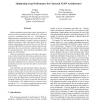Free Online Productivity Tools
i2Speak
i2Symbol
i2OCR
iTex2Img
iWeb2Print
iWeb2Shot
i2Type
iPdf2Split
iPdf2Merge
i2Bopomofo
i2Arabic
i2Style
i2Image
i2PDF
iLatex2Rtf
Sci2ools
IEEEPACT
2002
IEEE
2002
IEEE
Optimizing Loop Performance for Clustered VLIW Architectures
Modern embedded systems often require high degrees of instruction-level parallelism (ILP) within strict constraints on power consumption and chip cost. Unfortunately, a high-performance embedded processor with high ILP generally puts large demands on register resources, making it difficult to maintain a single, multi-ported register bank. To address this problem, some architectures, e.g. the Texas Instruments TMS320C6x, partition the register bank into multiple banks that are each directly connected only to a subset of functional units. These functional unit/register bank groups are called clusters. Clustered architectures require that either copy operations or delay slots be inserted when an operation accesses data stored on a different cluster. In order to generate excellent code for such architectures, the compiler must not only spread the computation across clusters to achieve maximum parallelism, but also must limit the effects of intercluster data transfers. Loop unrolling and ...
Distributed And Parallel Computing | IEEEPACT 2002 | Intercluster Data Transfers | Loop Unrolling | Register Bank |
| Added | 15 Jul 2010 |
| Updated | 15 Jul 2010 |
| Type | Conference |
| Year | 2002 |
| Where | IEEEPACT |
| Authors | Yi Qian, Steve Carr, Philip H. Sweany |
Comments (0)

